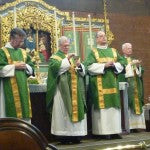 Green vestments worn by priests during Ordinary Time.
Green vestments worn by priests during Ordinary Time.
Image source: Lux Veritatis
The Christmas season has officially ended and now, the Church’s liturgical calendar has transitioned to the Ordinary Time, where its observance and customs revert once again for a period of time until the Lenten season and pausing before the start of Ash Wednesday. It is observed within Roman-rite Churches.
In a year, Ordinary Time isn’t simply a one-time period in the Church. After the end of Lent and Easter, the Church goes back once again until Advent and Christmas comes. Hence, it’s part of the whole cycle and is the most prominent of the seasons.
Liturgical Color
Vestments and various paraphernalia used in churches are changed from white to green to indicate what season it is. Green—in this case—symbolizes life, growth, and hope. This is especially relevant during Ordinary Time, as it is a phase where people are called to be faithful and observant to the precepts of Jesus Christ.
Time Period
Ordinary Time starts on the 9th or 10th or January, ending a day before Ash Wednesday, somewhere between February 4 and March 10, marking the beginning of the Lenten season. Lent continues until Easter Sunday with the celebration known as the “Solemnity of the Resurrection of Our Lord.” Easter ends on the Sunday between May 10 and June 13, leading back again to the Ordinary Time.
What to Do During Ordinary Time
Those who uphold the faith are expected to mature in their devotion and grow as better Christians. Spirituality is the key focus of believers during Ordinary Time. One must meditate upon the teachings of Jesus Christ, holding on to his words and his promise of eternal life—as the apostles did during his time on earth.
Lastly, Ordinary Time signifies the graces which draw more and more people to God. As we celebrate the season, let us all remember to strengthen our devotion and be drawn closer to Christ every step of the way. And before the Lenten season comes, take the opportunity to build up your commitment to God’s word.


